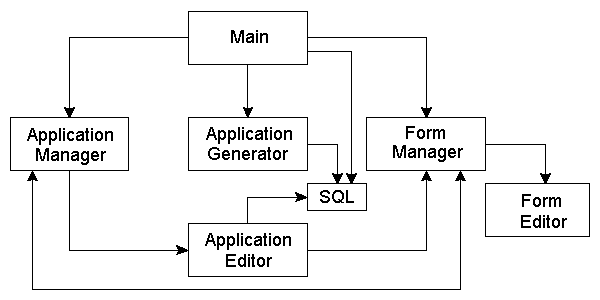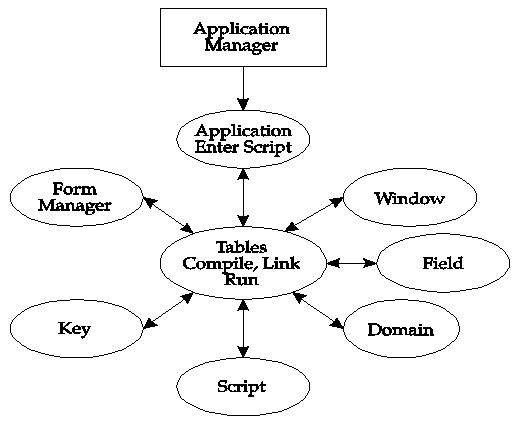CHAPTER 3: Empress 4GL Development Tools
Empress 4GL provides a set of tools to help you develop applications
effectively. A brief description of each of these tools can be found in
this chapter. Detailed information on how to use these tools are in the
Empress 4GL: Tools Reference manual.
The Empress 4GL development consists of the following:
-
Default Application Generator
-
Application Generator
-
Application Manager
-
Application Editor
-
Form Editor
-
Form Manager
-
Source Debugger
-
Executable Builder
-
Compiler and Linker
3.1 Default Application Generator
The Default Application Generator creates an interactive, window-based
application on one table which allows the user to perform select, insert,
update or delete operations by pressing a function key.
The Default Application Generator does not involve programming. Once
the table and application names are provided, it will create the application
based on the table definitions in the data dictionary. It is often used
for quick prototyping. Since the application generated by the Default Application
Generator is an Empress 4GL application, you can use the Application
Editor to modify the application.
The Default Application Generator can be found on Menu 2 of the Application
Manager.
3.2 Application Generator
The Application Generator creates an interactive menu-driven application
on one or more tables which allows the user to perform select, insert,
update or delete operations on the data in the Empress 4GL database.
The Application Generator does not involve programming. When using Empress
4GL to create an application, you will go through a series of menu
pages to pick and choose:
-
the desired screen layout
-
the tables and attributes that are involved in this application
-
the function keys that are available to the user
-
the qualification of the records
-
build custom help information
It is often used for simple applications or for quick prototyping.
Since the application that is generated from the Application Generator
is an Empress 4GL application, you can invoke the Application Editor
to modify the application.
The Application Generator is invoked through the Application Development
Main Menu.
3.3 Application Manager
The Application Manager allows you to create new applications and edit,
copy, delete and rename the existing applications. Through the Application
Manager, you may also invoke the Default Application Generator, Source
Debugger, compile, link and run the application.
The Application Manager is used more frequently during the development
phase. Quite often, during the development phase, there will be a requirement
to modify a particular form, the Application Manager allows you to escape
to the Form Manager without exiting the Application Manager.
The Application Manager is invoked through the Application Development
Main Menu.

Figure 3-1 4GL Application Development System
3.4 Form Manager
The Form Manager allows you to create new forms and edit, copy, rename
and delete existing forms. Forms are painted using the Form Editor.
The Form Manager is invoked through the Application Development Main
Menu.
The Form Manager is used frequently during the design and development
phase of the application. Forms can be created long before the actual development
starts.
3.5 Source Debugger
The Source Debugger is an Empress 4GL tool which is used to determine
where and why runtime errors are occurring. It is menu driven and uses
windows to display information which allow you to look at different parts
of the application which is being debugged.
The Source Debugger is used when the application is not functioning
the way it is intended. It allows the execution of a program to be stopped
and examined at various times. This allows you to determine where variables
are being set to the wrong values or the wrong branch of code is executed.
The Source Debugger is accessed through the Application Manager.
3.6 Application Editor
The Application Editor is a built-in editor that allows you to edit the
scripts which make up an application. You will be using the Application
Editor to modify existing scripts and write scripts of your own.
The format of the Application Editor reflects the structure of applications,
allowing you to write:
-
Application scripts
-
Window definitions
-
Field scripts
-
Key scripts
-
Subscripts
-
Domain definitions
Scripts are stored in Empress 4GL system tables, so the Application
Editor includes a menu allowing you to choose the table you wish to edit.
The window for editing the application enter and exit scripts is labeled
the "Application Table", the window for editing key scripts is labeled
the "Key Table", and so on. This menu is called the Tables Menu.
The Application Editor allows you to select scripts, modify them, and
update the tables. You can also write original scripts and insert them
into the tables, and delete scripts that are obsolete.

Figure 3-2 4GL Application Development System
3.7 Form Editor
The Form Manager provides you with the Form Editor. The Form Editor is
a full-screen editor that allows you to create, design and modify forms.
It simulates a blank sheet on which you can paint a form exactly the way
you want it to appear in your application. Editing a form consists of:
-
typing in background text
-
painting lines and boxes
-
creating and naming fields
You can also modify a form by repainting parts of it, and adding, moving
or removing fields.
3.8 Executable Builder
The Empress 4GL Executable Builder allows the user to build customized
executables which consist of zero or more terminal definitions and zero
or more linked applications compiled as read only runtime executables.
The Empress 4GL Executable Builder is invoked at the operating system
level by typing:
emp4bldx
3.9 Compiler and Linker
Compiling builds a library for an application; linking builds an executable
application by linking libraries together. All applications must be compiled
and linked before they are run.
When an application (or library) is compiled, it is checked for syntax
errors, valid window sizes and undefined variables. When an application
is linked, all references to window names, script names, external variables
and other items are resolved.
Compiling and linking is done through the Application Manager or the
Application Editor.


